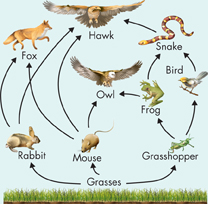6 Assessment
6.1 A Changing Landscape
Understand Key Concepts
Which of the following human activities has NOT had an important role in transforming the biosphere to date?
agriculture
industry
development
aquaculture
A resource that cannot easily be replenished by natural processes is called
common.
renewable.
nonrenewable.
conserved.
Describe how Hawaiian settlers negatively affected the islands after the 1700s.
Name four services that ecosystems provide for the biosphere.
Think Critically
Propose a Solution Devise guidelines your biology class can use to dispose of its nonlab trash in a safe, “environmentally friendly” way.
Compare and Contrast How are renewable and nonrenewable resources alike? How are they different?
Form a Hypothesis Monoculture fields are usually very large and homogeneous. Do you think this makes them more or less vulnerable to disease and pests? Explain.
6.2 Using Resources Wisely
Understand Key Concepts
The conversion of a once soil-rich area to an area of little to no vegetation is called
fragmentation.
deforestation.
desertification.
acid rain.
The loss of fertile soils from an area through the action of water or wind is called
acid rain.
erosion.
desertification.
monoculture.
The concept of using natural resources at a rate that does not deplete them is called
conservation.
sustainable development.
reforestation.
successful use.
Examine the food web below. Which of the following organisms would accumulate the highest levels of a pesticide?
hawk
rabbit
frog
grasses
What is the difference between sustainable forestry and deforestation?
Identify some of the common sources of water pollution.
Think Critically
Design an Experiment Can covering soil with mulch or compost near the bases of plants help reduce soil erosion? Design an experiment to answer this question.
Calculate The concentration of a toxic chemical is magnified ten times at each trophic level. What will the concentration of the toxin be in organisms at the fifth trophic level if primary producers have concentrations of 40 parts per million?

Infer Why are lakes that have been affected by acid rain often clear and blue?
Table of Contents
- Formulas and Equations
- Applying Formulas and Equations
- Mean, Median, and Mode
- Estimation
- Using Measurements in Calculations
- Effects of Measurement Errors
- Accuracy
- Precision
- Comparing Accuracy and Precision
- Significant Figures
- Calculating With Significant Figures
- Scientific Notation
- Calculating With Scientific Notation
- Dimensional Analysis
- Applying Dimensional Analysis





